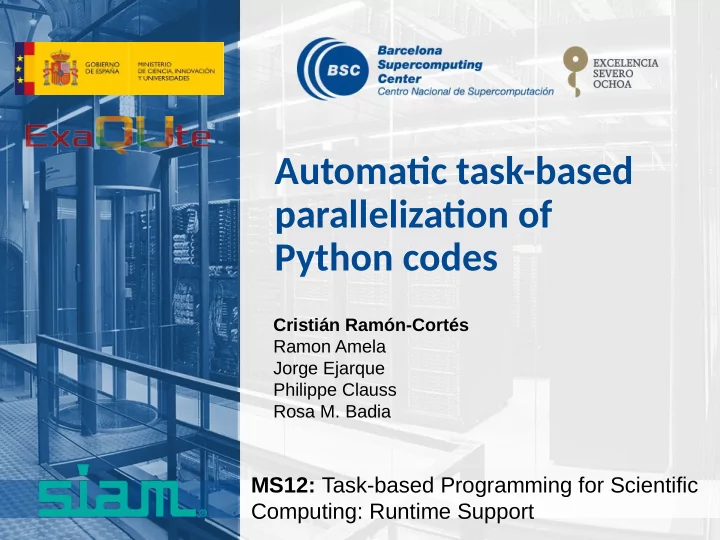

Automatjc task-based parallelizatjon of Python codes Cristián Ramón-Cortés Ramon Amela Jorge Ejarque Philippe Clauss Rosa M. Badia MS12: Task-based Programming for Scientific Computing: Runtime Support
Outline Introductjon ● PLUTO ● PyCOMPSs AutoParallel ● Annotatjon ● Architecture Evaluatjon Conclusions and Future Work
Introductjon
Motjvatjon Identjfying parallel regions Remote executjon Distributed Concurrency management Parallel Data transfers Issues Issues Executjon orchestratjon Ease the development of distributed applicatjons THE GOAL: Any fjeld expert can scale up an applicatjon to hundreds of cores 4
COMPSs Based on sequentjal programming ● General purpose programming language + annotatjons Task-based programming model ● Task is the unit of work ● Implicit Workfmow: Builds a task graph at runtjme that expresses potentjal concurrency 5
COMPSs Infrastructure agnostjc ● Same applicatjon runs on clusters, grids, clouds and containers Supports other types of parallelism ● Multj-threaded tasks (i.e., MKL kernels) ● Multj-node tasks (i.e., MPI applicatjons) ● Non-natjve tasks (i.e., binaries) ● Nested PyCOMPSs applicatjons ● Integratjon with BSC OmpSs 6
PyCOMPSs Annotatjon Python decorators for task selectjon + synchronizatjon API Instance and class methods Task data directjons @task (returns=dict) def wordcount(block): ... @task (a=IN, b=IN, c=INOUT) def multiply_acum(a, b, c): @task (result=INOUT) c += a * b def reduce(result, pres): ... @task (returns=int) def multiply(a, b, c): def main(a, b, c): return c + a * b for block in data: @constraint (computingUnits=”2”) pres = wordcount(block) @task (file=FILE_IN) reduce(result, pres) def my_task(x): result = compss_wait_on(result) ... # f = compss_open(fn) @binary (binary=”sed”) # compss_delete_file(f) @task (f=FILE_INOUT) # compss_delete_object(o) def binary_task(flag, expr, f): # compss_barrier() pass 7
PLUTO ▶ The Polyhedral Model represents the instances of the loop nests’ statements as integer points inside a polyhedron ▶ PLUTO is an automatjc parallelizatjon tool based on the Polyhedral Model to optjmize arbitrarily nested loop sequences with affjne dependencies 8
AutoParallel
AutoParallel A single Python decorator to parallelize and distributedly execute sequentjal code containing affjne loop nests Automatjc Automatjc Python decorator Python decorator taskifjcatjon taskifjcatjon from pycompss.api.parallel import parallel @parallel () No data No data def matmul(a, b, c, m_size): for i in range(m_size): management management for j in range(m_size): for k in range(m_size): c[i][j] += np.dot(a[i][k], b[k][j]) Sequentjal code Sequentjal code No resource No resource management management task task task task task task task task task task task task Grid Cluster Cloud Container 10
AutoParallel Annotatjon ▶ Taskifjcatjon of affjne loop nests at runtjme @parallel () def matmul(a, b, c, m_size): for i in range(m_size): for j in range(m_size): for k in range(m_size): c[i][j] += np.dot(a[i][k], b[k][j]) # [COMPSs AutoParallel] Begin Autogenerated code @task (var2=IN, var3=IN, var1=INOUT) def S1(var2, var3, var1): var1 += np.dot(var2, var3) def matmul(a, b, c, m): if m >= 1: for t1 in range(0, m – 1): #i lbp = 0 ubp = m - 1 for t2 in range(lbp, ubp + 1): #k lbv = 0 ubv = m - 1 for t3 in range(lbv, ubv + 1): #j S1(a[t1][t2], b[t2][t3], c[t1][t3]) compss_barrier() # [COMPSs AutoParallel] End Autogenerated code 11
AutoParallel Architecture Decorator ● Implements the @parallel decorator Python to OpenScop translator ● Builds a Python Scop object from the Python’s AST representjng each affjne loop nest detected in the user functjon Parallelizer ● Parallelizes an OpenScop fjle and returns its Python code using OpenMP syntax Python to PyCOMPSs translator ● Inserts the PyCOMPSs syntax (task annotatjons and data synchronizatjons) to the annotated Python code (uses Python’s AST) Code replacer ● Replaces each loop nest in the initjal user code by the auto-generated code 12
Evaluatjon
Cholesky LoC Lines Of Code Code Analysis CC Cyclomatic Complexity NPath Npath Complexity LoC CC NPath User 220 26 112 Auto 274 36 14.576 Loop Analysis #Main #Total Depth User 1 4 3 Auto 3 9 3 Problem Size Execution Total Matrix Task SpeedUp #Blocks Block Size #Tasks Size Types @ 192 cores User 3 6.512 1,95 65.536 x 65.536 32 x 32 2048 x 2048 Auto 4 7.008 2,04 14
LU LoC Lines Of Code Code Analysis CC Cyclomatic Complexity NPath Npath Complexity LoC CC NPath User 238 35 79.872 Auto 320 39 331.776 Loop Analysis #Main #Total Depth User 2 6 3 Auto 2 6 3 Problem Size Execution Total Matrix Task SpeedUp #Blocks Block Size #Tasks Size Types @ 192 cores User 4 14.676 2,45 49.152 x 49.152 24 x 24 2048 x 2048 Auto 12 15.227 2,13 15
LU ▶ In-depth performance analysis ● Paraver trace with 4 workers (192 cores) UserParallel AutoParallel 16
QR LoC Lines Of Code Code Analysis CC Cyclomatic Complexity NPath Npath Complexity LoC CC NPath User 303 41 168 Auto 406 43 344 Loop Analysis #Main #Total Depth User 1 6 3 Auto 2 7 3 Problem Size Execution Total Matrix Task SpeedUp #Blocks Block Size #Tasks Size Types @ 192 cores User 4 19.984 2,37 32.768 x 32.768 16 x 16 2048 x 2048 Auto 20 26.304 2,10 17
Conclusions and Future Work
Conclusions and Future Work ▶ AutoParallel goes one step further in easing the development of distributed applicatjons ● It is a Python module to automatjcally parallelize affjne loop nests and execute them in distributed infrastructures ● The evaluatjon shows that the automatjcally generated codes for the Cholesky, LU, and QR applicatjons can achieve the same performance than the manually parallelized versions ▶ Next steps ● Loop taskifjcatjon: An automatjc way to create blocks from sequentjal applicatjons based on loop tjles. Requires: ─ Research on how to simplify the chunk accesses from the AutoParallel module ─ Extend PyCOMPSs to support collectjon objects (e.g., lists) ● Integratjon with difgerent tools similar to PLUTO to support a larger scop of loop nests (e.g., APOLLO) 19 19
Thank you cristianrcv/pycompss-autoparallel http://compss.bsc.es/ cristian.ramon-cortes@bsc.es
Recommend
More recommend